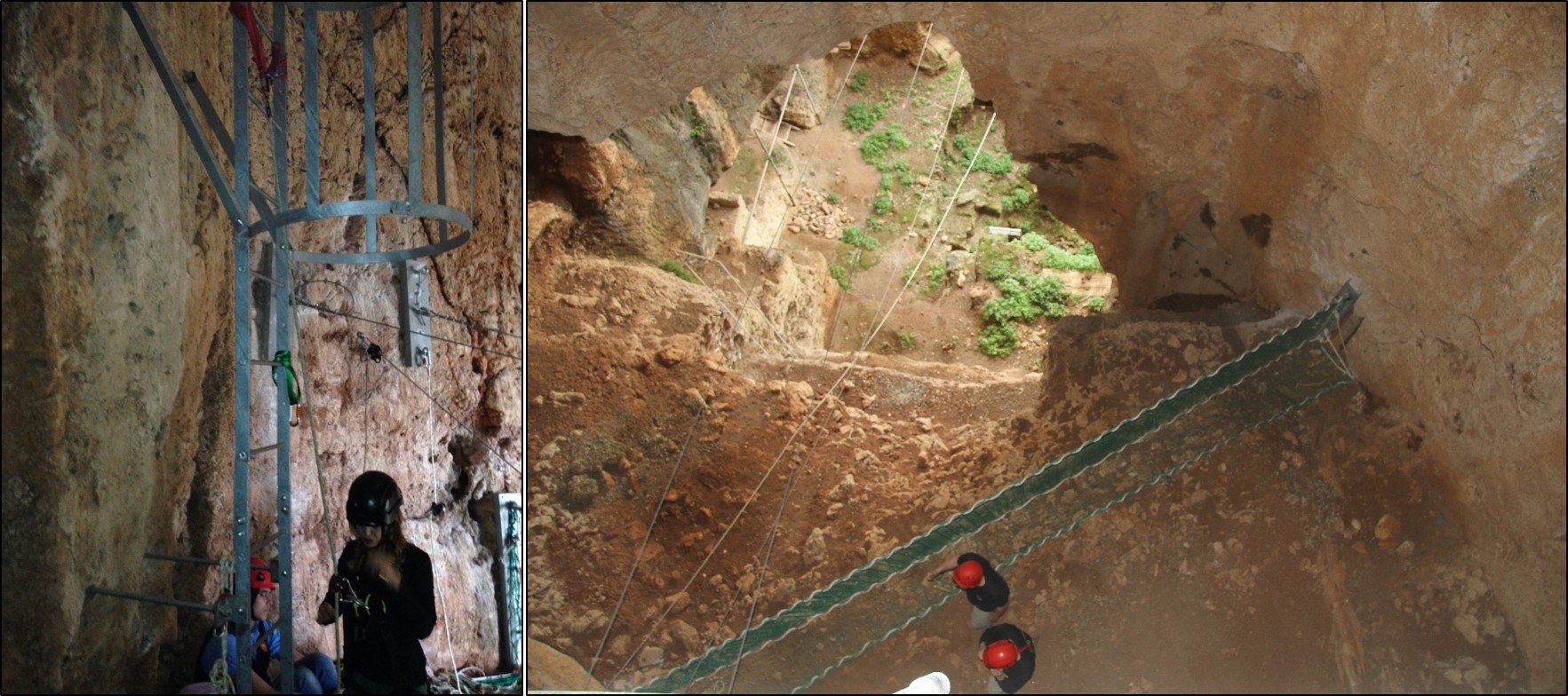Tabun Cave
In collaboration with Mina Weinstein-Evron1 and Ron Shimelmitz1
1 Zinman Institute of Archaeology, University of Haifa, Mount Carmel 3498838, Haifa, Israel
Tabun Cave is located at the western edge of Mount Carmel, at the opening of Nahal Me'arot. It was first excavated between 1929 and 1934 by D.A.E. Garrod (Garrod and Bate, 1937). The total depth of sediments in the cave is 25 meters. Garrod divided the stratigraphical sequence into seven layers, ranging from the Lower Paleolithic to the late Middle Paleolithic. Three of these layers are attributed to the Middle Paleolithic, including Layer D of the early Middle Paleolithic, Layer C of the middle Middle Paleolithic, and Layer B of the late Middle Paleolithic. Each of these layers represents a different phase in the Levantine Middle Paleolithic (Shea, 2003; Hovers, 2009).

During the 1930s, excavation revealed several human remains in layers B and C. The most famous of this is C1; the Neanderthal woman that was found in the interface between Layers C and B (McCown and Keith, 1939). While its attribution to a specific layer was left in question by Garrod (Garrod and Bate, 1937), it is most often assigned today to Layer B (Bar-Yosef and Callander, 1999). Many more human remains were found within Layer B (McCown and Keith, 1939), including dental remains (Coppa et al., 2005). The finding of Neanderthal remains in Layer B correlates with other sites dated to the late Middle Paleolithic (Bar-Yosef et al., 1992; Hovers et al., 1995; Akazawa et al., 1999). Nevertheless, while numerous Middle Paleolithic sites are scattered throughout the Levant, in most of these no human remains were found. Tabun Cave is one of the rare exceptions with rich human remains, including burials (Shea, 2001, 2003).
Since the 1930s, two other excavation expeditions at Tabun Cave were made. One by A. Jelinek between 1967 and 1971 (Jelinek et al., 1973; Jelinek, 1982), and the second by A. Ronen between 1975 and 2003 (Ronen et al., 2011). Ronen excavated the Lower Paleolithic layers at the cave, while Jelinek excavated a 10-meter step section at the middle of the former section made by Garrod. Jelinek's section covered Garrod's Layers E-C, ranging from the Lower Paleolithic to the middle of the Middle Paleolithic. Layer B was not included in Jelinek’s trench, and, thus, this part of the cave was not excavated since 1934 despite is enormous potential. The potential of a new excavation is further echoed in that studies of aNDA from the last decade which hypothesize the Levantine late Middle Paleolithic as the time and place of gene-flow between Neanderthals and Homo sapiens (Sankararaman et al., 2012; Kuhlwilm et al., 2016).
In 2017, a new excavation was initiated in Tabun Layer B by Mina Weinstein-Evron, Ron Shimelmitz and Israel Hershkovitz from the University of Haifa and Tel Aviv University. Through the excavation, we aim to meet these goals:
- Gain a better understand of the stratigraphy of this part of the sequence, including its environment of deposition and post depositional processes
- Provide for the first time a comprehensive chronological frame for this layer using a variety of methods
- Reconstruct the paleo-environment and human exploitation of it using a set of studies of biotic remains
- Track anthropogenic signatures within the sediments such as the extent of fire use using micromorphology
- Identify patterns in material culture referring to cognition, landscape exploitation, site use and the transformation of socially learned knowledge
- Search new human remains that will help understand the contact between Neanderthals and Homo sapiens at the late Middle Paleolithic
In all, this cluster of studies is expected to fill-in important gaps in our knowledge that are significant to develop new models for reconstructing Neanderthal migration into the Levant and their extinction at the late Middle Paleolithic, as well as Neanderthals-Homo sapiens relationship.
Setting the Ground for the New Excavation: The construction of a ladder and fence

The lower part of the 13 meter long ladder, the fence that protect excavators and the set of two cables: one for shifting sediments and equipment and one for emergency evacuation
In order to enable easy and safe access to the very upper layer (B), which is the target of the current excavation project, a ladder was built running through the cave's chimney. This was also performed in order to keep the step section below, which runs from the Lower to the Middle Paleolithic, intact and unharmed. The construction of the ladder and its specific location was coordinated with the Israel Nature and Parks Authority. It was designed and built by a company that specializes in working at high altitudes –'Vertical Solutions.' The construction procedures were accompanied by 'Aagam Safety' – a safety engineer – that constructed the working scheme at the cave as well. The ladder is 13 m long with its head at the upper opening of the chimney. A set of two doors, locked by keys, was constructed at the roofed ceiling that covers the cave's chimney. A resting zone was made at the center of the ladder as requested by the safety regulation.

